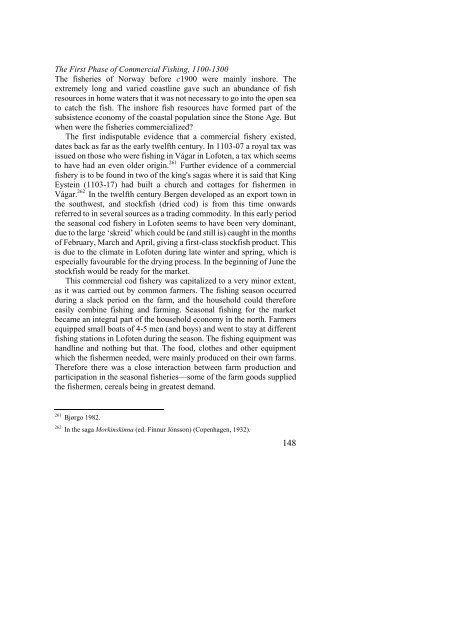The North Atlantic Fisheries, 1100-1976 - University of Hull
The North Atlantic Fisheries, 1100-1976 - University of Hull
The North Atlantic Fisheries, 1100-1976 - University of Hull
Create successful ePaper yourself
Turn your PDF publications into a flip-book with our unique Google optimized e-Paper software.
<strong>The</strong> First Phase <strong>of</strong> Commercial Fishing, <strong>1100</strong>-1300<br />
<strong>The</strong> fisheries <strong>of</strong> Norway before c1900 were mainly inshore. <strong>The</strong><br />
extremely long and varied coastline gave such an abundance <strong>of</strong> fish<br />
resources in home waters that it was not necessary to go into the open sea<br />
to catch the fish. <strong>The</strong> inshore fish resources have formed part <strong>of</strong> the<br />
subsistence economy <strong>of</strong> the coastal population since the Stone Age. But<br />
when were the fisheries commercialized?<br />
<strong>The</strong> first indisputable evidence that a commercial fishery existed,<br />
dates back as far as the early twelfth century. In 1103-07 a royal tax was<br />
issued on those who were fishing in Vágar in L<strong>of</strong>oten, a tax which seems<br />
to have had an even older origin. 261 Further evidence <strong>of</strong> a commercial<br />
fishery is to be found in two <strong>of</strong> the king's sagas where it is said that King<br />
Eystein (1103-17) had built a church and cottages for fishermen in<br />
Vágar. 262 In the twelfth century Bergen developed as an export town in<br />
the southwest, and stockfish (dried cod) is from this time onwards<br />
referred to in several sources as a trading commodity. In this early period<br />
the seasonal cod fishery in L<strong>of</strong>oten seems to have been very dominant,<br />
due to the large ‘skreid’ which could be (and still is) caught in the months<br />
<strong>of</strong> February, March and April, giving a first-class stockfish product. This<br />
is due to the climate in L<strong>of</strong>oten during late winter and spring, which is<br />
especially favourable for the drying process. In the beginning <strong>of</strong> June the<br />
stockfish would be ready for the market.<br />
This commercial cod fishery was capitalized to a very minor extent,<br />
as it was carried out by common farmers. <strong>The</strong> fishing season occurred<br />
during a slack period on the farm, and the household could therefore<br />
easily combine fishing and farming. Seasonal fishing for the market<br />
became an integral part <strong>of</strong> the household economy in the north. Farmers<br />
equipped small boats <strong>of</strong> 4-5 men (and boys) and went to stay at different<br />
fishing stations in L<strong>of</strong>oten during the season. <strong>The</strong> fishing equipment was<br />
handline and nothing but that. <strong>The</strong> food, clothes and other equipment<br />
which the fishermen needed, were mainly produced on their own farms.<br />
<strong>The</strong>refore there was a close interaction between farm production and<br />
participation in the seasonal fisheries—some <strong>of</strong> the farm goods supplied<br />
the fishermen, cereals being in greatest demand.<br />
261 Bjørgo 1982.<br />
262 In the saga Morkinskinna (ed. Finnur Jónsson) (Copenhagen, 1932).<br />
148















